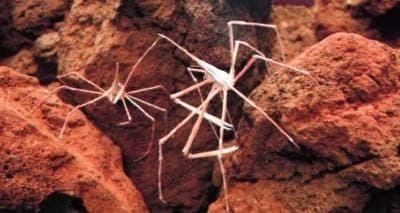Home › Sea Life › Marine Biology › Invertebrates › Sea Arthropods
Interesting Facts about Sea Spiders
[Phylum: Arthropoda] [Order: Pantopoda] [Class: Pycnogonida] [Family: Chelicerata (claw-bearers)]
Even though there are more than 1,300 documented species of underwater spiders (with eight legs), they are not true spiders such as those within the order Araneae.
This section contains fun facts and information about marine arthropods, including where spiders live in the ocean, how they eat, and which species are the most dangerous for humans.
Marine Arthropods: Habitat and Distribution
You'll find all the common underwater spiders inhabiting shallow waters almost anywhere in the world.
That said, they will be highly camouflaged with their environment (e.g. among algae and coral ecosystems), so they are not easy to spot.
But, there are some sea spiders that prefer to live in the deep and dark oceans.
In fact, deeper than seven (7) kilometres for some pycnogonids! Thus, they cope well with the extremes of warm temperatures and polar ice.
In shallow zones, they thrive better near the coastal shores, sheltering among the seaweed. But, it's the largest species of sea spiders (about 20% of them) that can endure the coldest, deepest waters around Antarctica.
Sea Spiders Behaviour and Characteristics
Like their terrestrial counterparts, marine spiders have long spindly legs, usually eight, that flare out from a small abdomen. These solitary creatures crawl around vibrant coral ecosystems and sea anemones.
A series of multiple leg joints help them to stand up and move around on the ocean floor. These appendages also contain the digestive tract for removing waste products.
Instead of a traditional respiratory system, these spiders live underwater. Hence, they use diffusion to absorb and release gases through their legs.
Here's the thing:
Marine arthropods use the toothless proboscis to syphon nutrients from their prey. It travels through the digestive system and into their legs.
The size of the different species of sea spiders varies a lot. While some are miniscule, measuring no more than one (1) millimetre, others can grow over eighty (80) centimetres (almost 3 feet).
It is common for Chelicerata to have four (4) eyes on the sides of their head. Even so, some of the species seen by blackwater divers do not have any eyes whatsoever.
 Sea Spider Abdomen
Sea Spider Abdomen
The abdomen of a marine spider is usually thin and narrow, but it can support four pairs of spindly legs.
However, some specimens will have a few extra pairs of legs attached to the head.
They use the 'chelicerae' jaws to grab food. Whereas, other sensory and reproductive appendages can carry the eggs of pregnant females.
What and How Do Sea Spiders Eat?
The best swimmers tend to be the ones with long legs. But, all invertebrate spiders that live in water will feed on stationary (or slow-moving) soft-bodied prey, such as:
- Anemones
- Coral (soft corals)
- Clams
- Jellyfish
- Marine worms
- Nudibranchs
- Sea sponges
They are omnivorous feeders that use their legs to pierce their catch. Then, these underwater vampires use their proboscis to suck out the nutrients (e.g. blood and other bodily fluids).
Sea Spider Reproductive Process
Besides being used for grooming purposes, a pair of ovigers is where a sea spider will keep their eggs. The legs are also the location for the male and female genitalia.
After alignment of the genital pores, the female will release the eggs to mix with the male sperm. Thus, the egg fertilisation process takes place externally.
Baby Sea Spiders
Once the sperm has stuck to the eggs, the male will collect them. The male spider carries the fertilised eggs in his ovigers until they hatch.
After hatching, the larvae (babies) emerge and most of them will swim away from the parent to begin the molting process. Further development takes place until they become adults with functional pairs of legs.
Threats and Predators
For the most part, sea spider predators include most of the larger carnivorous or omnivorous creatures, including sea stars, crabs, and rayfish.
Pro Tip: There aren't many natural threats to the survival of sea spiders species. But, sudden changes to oceanic ecosystems (e.g. water temperatures) is one that can affect the populations.
Fun Facts about Sea Spider Species
- There are about 1,500 known species of sea spiders and some of them have ten (10) or twelve (12) legs.
- Courtship rituals between males and females are brief. But, Ascorhynchus corderoi is hermaphroditic - meaning it possesses ovaries and testes.
- Accurate information about the lifespan of sea spiders is limited. Nonetheless, their legs will start to wither and become shorter as they age. As a result, they will resort to parasitic feeding methods due to the reduction in movement.
Related Information and Help Guides
- Annelida Characteristics: Facts about Annelids
- Echinodermata Facts and Information with Pictures
- Marine Invertebrates List of Animals from A to Z
Note: The short video [1:03 seconds] presented by National Geographic contains footage explaining how sea spiders 'breathe through their legs' and pump oxygen through the gut.